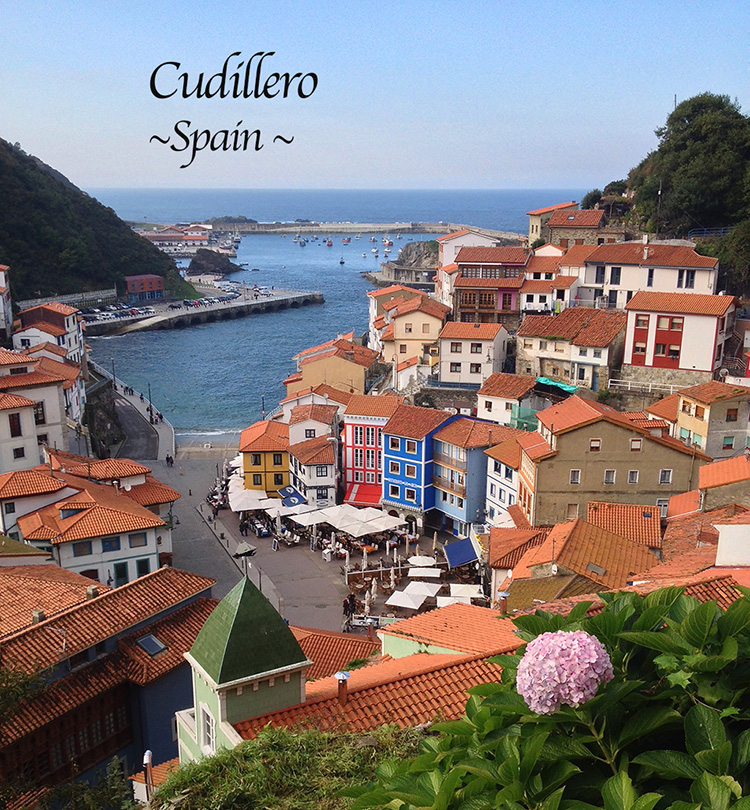
After experiencing the merciless sun, dust and parched hills of southern Spain, I decided to head north in search of my favourite colour – green. It was here that I discovered a land of lush meadows, jagged mountains, stews, cider and Celtic culture. It was also here that I discovered I was much happier. So without further ado, here are eight unusual things to do in Asturias, my favourite region in Spain.
Unusual Things to do in Asturias: Elogio del Horizonte – Gijón
If one day you find yourself in the far north of Spain in a city called Gijón, pay a visit to Elogio del Horizonte (Eulogy to the Horizon). This sculpture by Eduardo Chillida towers like an Ikea fastener at the edge of the Cantabrian Sea. Stand inside the sculpture and you’ll experience the amplified sounds of this mesmerising body of water. The surrounding hilltop of Santa Catalina is also a wonderful place to explore.

The Laneways of Cudillero
Further west along the northern coast of Spain lies the quaint fishing/tourist village of Cudillero. One of the things I liked most about it were the houses, which cascade down the hillside as if they’re tumbling in upon one another. Between the houses you’ll find one of the most interesting things to do in Asturias – explore the zigzagging laneways. Here cats congregate, fish hang from balconies and passageways beckon like a secret beneath kitchen windows.



The house of Rosario de Acuña – Gijón
Just south of Gijón along the coastal walk are clifftops with an often bleak, windswept view of the sea. Here you’ll find the old house of a lady named Rosario de Acuña – a Spanish writer from the 19th-century. Known as a radical free thinker in her time, Rosario became the first woman playwright to have a theatre closed down. A small plaque depicts lines of a poem she wrote about Gijón – the city in which she died and loved.


Los Cubos de la Memoria – Llanes
Strewn across the shoreline of Llanes like some giant’s playpen, Los Cubos de la Memoria (the cubes of memory) is one of the more unusual things to do in Asturias. A colourful artwork created in 2001 by Agustín Ibarrola, the cubes lend wonderful atmosphere to the karst ridge of Sierra de Cuera, which towers 750 metres above the surrounding area. They also create quite an impression against the Cantabrian Sea and fishing boats which frequent the edge of this attractive little town.


The Spring of Covadonga
Covadonga is a magical place that’s sacred to Spain, as it’s the site of the legendary 8th-century battle where the Christians defeated the Moors in their ‘reconquest’ of Spain. Here lies a holy cave in the mountain known as Auseva. Beneath this is a spring, which – according to legend – bestows happiness and even marriage upon any who drink from it. I did and now I’m engaged, so I think it works!



The tomb of Pedro Menéndez – Avilés
Roughly halfway between Cudillero and Gijón lies the notoriously industrial city of Avilés. This underrated city contains many treasures, such as the one inside the 12th-century Iglesia de los Padres Franciscanos (Church of the Franciscan Fathers). Here you’ll find the tomb of Pedro Menéndez de Avilés, who founded the first city in the United States of America – St. Augustine, Florida. A walk inside the church and a visit to his tomb is one of the more intriguing things to do in Asturias.

The Sudarium of Oviedo
Thought of as one of the world’s great religious mysteries, the Sudarium of Oviedo is a blood stained cloth believed to have been wrapped around the head of Christ after he died. The cloth – which has been tested to contain the same blood as the Turin shroud – is publicly displayed at the Catedral de San Salvador (Oviedo Cathedral) three times a year in the stylish town of Oviedo. Unfortunately I was there at the wrong time and missed it entirely.

Indianos houses – Llanes
During the 19th-century, Spanish men made their fortune in countries such as Argentina, Cuba and Mexico. Upon returning to Spain they constructed ostentatious mansions, many of which were abandoned and now lay forlorn and crumbling in the regions of Asturias and Galicia. Llanes contains a few such examples, which are fascinating to look at and ponder their briefly happy, yet mostly forgotten lives. The houses were called Indianos as the Spanish referred to the Americas as ‘the Indias’.


What about you? Have you been to northern Spain? Do you know of any unusual things to do in Asturias? Let me know in the comments…

I’ve always been more attracted to the dust bowl in the south, but have to say, the north looks good too – even if it’s just to stand under that fountain.
I love the south too Nina, particularly Ronda. For me the south is a place for a good holiday, while the north is a place to live.